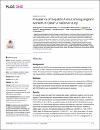Prevalence of hepatitis A virus among migrant workers in Qatar: A national study

Date
2024-07-01Author
Younes, NadinChemaitelly, Hiam
Nizamuddin, Parveen Banu
Al-Hamad, Tasneem
Abdallah, Marah
Yassine, Hadi M.
Abu-Raddad, Laith J.
Nasrallah, Gheyath K.
...show more authors ...show less authors
Metadata
Show full item recordAbstract
Background Hepatitis A virus (HAV) is the predominant cause of acute viral hepatitis worldwide; however, data on HAV antibody prevalence (seroprevalence) among migrant populations are limited. This study aimed to investigate HAV seroprevalence among Qatar’s migrant craft and manual workers (CMWs), constituting approximately 60% of the country’s population. Methods HAV antibody testing was conducted on stored serum specimens obtained from CMWs during a nationwide severe acute respiratory syndrome coronavirus 2 (SARS-CoV-2) population-based cross-sectional survey between July 26 and September 9, 2020. Associations with HAV infection were investigated through regression analyses. Results Of the 2,607 specimens with HAV antibody test results, 2,393 were positive, and 214 were negative. The estimated HAV seroprevalence among CMWs was 92.0% (95% CI: 90.9–93.1%). HAV seroprevalence was generally high but exhibited some variation, ranging from 70.9% (95% CI: 62.4–78.2%) among Sri Lankans to 99.8% (95% CI: 98.2–99.9%) among Pakistanis. The multivariable regression analysis identified age, nationality, and educational attainment as statistically significant factors associated with HAV infection. Relative to CMWs aged ≤29 years, the adjusted relative risk (ARR) was 1.06 (95% CI: 1.03–1.10) in CMWs aged 30–39 years and reached 1.15 (95% CI: 1.10–1.19) in those aged ≥50 years. In comparison to Indians, the ARR was lower among Sri Lankans, assessed at 0.81 (95% CI: 0.72–0.91), but higher among Nepalese at 1.07 (95% CI: 1.04–1.11), Bangladeshis at 1.10 (95% CI: 1.07–1.13), Pakistanis at 1.12 (95% CI: 1.09–1.15), and Egyptians at 1.15 (95% CI: 1.08–1.23). No evidence for differences was found by geographic location or occupation. Conclusions HAV seroprevalence among Qatar’s CMW population is very high, with over nine out of every ten individuals having been exposed to this infection, likely during childhood.
Collections
- Biomedical Research Center Research [764 items ]
- Biomedical Sciences [763 items ]
- Public Health [462 items ]

